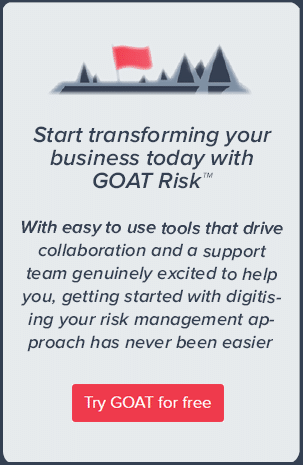
Risk Management Software - Simplicity over Complexity
How Ian Peter (CFO) at LUCELEC chose simplicity over complexity to deliver a risk management software solution perfectly tailored to his business needs.
St. Lucia Electricity Services Limited (LUCELEC) delivers efficient energy services that are safe, reliable, and environmentally responsible. It is a catalyst for social and economic development in Saint Lucia whilst meeting the expectations of customers, shareholders and employees.
The headlines
- Simplicity over complexity
- Recognising business challenges
- Choosing the right tool for the job
- A lightbulb moment for LUCELEC
- Everything that Excel can do and so much more
- Managing cost
- Not just a software provider
- The sky’s the limit with customised development
- Facilitating strategic debate and decision making
- Five key reasons why LUCELEC recommends GOAT Risk™
Simplicity over complexity
When Ian Peter (CFO) of LUCELEC was searching for a risk management tool to replace his outdated Excel risk register, he started by reaching out to a risk management consultancy in Canada for advice.
The software tool they recommended was a well known and respected tool in the risk management marketplace that comes with a plethora of features and functionality matched by a substantial price tag.
Ian spent nearly a year consulting with the provider about their proposed solution, and was close to moving forwards before something made him hold back.
“I found it expensive and it was like I was buying an entire apartment building for me to only then use two apartments. It was good and yes, it was a nice selling point that I would have 15 units and as things developed, I could spread out and utilise these. But the point is, I only needed two. But I would still have to pay for 15. So, I kind of hesitated.”
Paying for functionality and features he didn’t need was one aspect that Ian wasn’t comfortable with, but he was also worried that the tool was perhaps just too complicated, necessitating a lengthy rollout period involving the IT department and requiring user training.
“Because you’re buying 15 units, it’s complex to use and there would have been a need for a lot of training. Therefore, I felt the change management approach would be too cumbersome.”

Recognising business challenges
Ian was already finding it difficult to get input to his ‘cumbersome Excel risk register’ from managers around the business and he worried that the proposed tool would make it worse, not better.
“It was challenging getting my managers to even use Excel spreadsheets as a risk register tool. I thought, if I bring in this complicated software, will I scare them? They may not even use it and I’ll just be left with an expensive solution that’s not really adding any value.”
Choosing the right tool for the job
Ian’s key motivation for moving from an Excel risk register to a risk management software tool was so he could start improving the way LUCELEC managed risks across its business.
“It was really about risk management. Risk reporting is just a part of it, but I wanted to get risk owners to really engage with the process and use it to help them manage their operations.”
That meant a tool that was easy to use, and which would be welcomed and adopted across the business – not necessarily one with all the bells and whistles.
“As the person in charge of it, it doesn’t really matter whether I think I have a ‘Rolls Royce’ solution that’s fantastic. It’s about whether managers will find it easy to use and actually incorporate into their daily work.”
Ian sought advice from his fellow members at the Risk and Insurance Management Society (RIMS). His request was straightforward:
“I’m looking for risk management software. Is there anything else? What can you all recommend? I want something simple. I’m moving from Excel.”
At this point, someone suggested GOAT Risk.
The first thing that caught Ian’s attention was the 30 day free trial period, offering full access to the tool.
“Now, a lot of software companies don’t do that. They give you a trial, but it’s a glimpse into the software – you can’t really upload all your information and get it working.”
A lightbulb moment for LUCELEC
Once Ian started testing GOAT, he was quickly able to figure out how it could work for him and how it compared to the tool he’d just been about to buy.
“It was cheaper. It was fast. I thought I would be able to switch my people over to it much more easily. I could do the training myself. I didn’t need anyone, because it was just so intuitive that I figured it out and I learned how to do everything. That’s how I ended up with GOAT Risk.”
Everything that Excel can do and so much more
Ian easily transferred all of his risks from Excel into GOAT within the 30 day trial period. He wanted to make sure it could do everything that Excel could do and wanted to hand over a completed risk profile to each of his managers so they could hit the ground running with their new responsibility of risk identification and management for their own departments.
“I didn’t even get my managers to enter their risk registers in GOAT. I decided to do it myself because I wanted to handover something that was already built and ready to work with.”
Managing cost
“What really stood out for me was the way I could control the cost of the software through user numbers. I realised I would only initially need around 15 or so, but a lot of the other software providers sell packages where I would need to buy space for a lot more users than I would

Not just a software provider
“Once I started our monthly subscription, what really impressed me was the closeness of the developer. I’ve never used any software that is so important to an organisation, a critical area, where you have a really close interaction with the developers. I would send an email and always get a response the same day. That really shocked me to be honest.”
“I thought it was amazing that I didn’t just get software. I actually got a connection with someone selling and developing it, so that I can have that personal exchange. It accelerated my learning as well because I could just get an immediate response as I was trying to figure things out.”
The sky’s the limit with customised development
“The ability to do custom development was an even bigger selling point for me. I can figure out what I need to do to make the software work better for LUCELEC and then work with GOAT to get it done.”
“If I want to enhance the functionality, let’s say around risk reporting for example, to make it better for LUCELEC, I’m willing to pay for it. I can get it done. The sky’s the limit really. I think it’s a fantastic model.”
Facilitating strategic debate and decision making
Whilst the rollout of GOAT across the business is in its early stages, Ian has already had the chance to use the tool for Strategy Planning and is delighted at how it helped contribute to the debate.
“One of the things that was a real huge plus for us is that we recently went about planning our strategy for the next 15 years. As a part of the process, we needed to identify risks to the strategy. We just finished setting up GOAT and so were able to use it to help facilitate the process.”
“Whilst we had our discussions, we talked about controls, what the mitigation plans are, who should own them, and what the timings should be. Risk management and strategy is a big thing, and we were able to use GOAT to help.
We had a tool at our disposal that we could use and it’s so intuitive, the management consultants we were working with at the time were able to pick it up and run with it without any training needed.”
Five key reasons why LUCELEC recommends GOAT Risk™:
“The fact that you can try all the functionality before you decide to go with it. That is key. I would tell anyone considering risk management software, it’s free to try, and once you get into it and you think it works for you, then great – buy it!”
- It’s simple to move across from Excel spreadsheets
“It’s so easy. If you already use Excel, it’s not a hard sell to switch to GOAT because it’s very simple to bring across your existing risks and risk profiles and create new ones with a simple drag and drop risk assessment tool.”
- Scalability and cost management
“If you decide you only want one person to have access to GOAT, you just pay for one. As you expand, you just get more people to become users on the system and pay as you go. It’s scalable. That’s the point – a small organisation can use it too.”
- Excellent customer support
“As an example, I couldn’t initially figure out how to use the Key Risk Indicator functionality. I had a session with Danny, the CEO to discuss this – and then by the end of the chat, it was like a bell went off in my head and I had figured out how to do this. Now, I’m an expert on GOAT – in fact, if you need me to train anyone, I can!”
- Ability to customise the tool
“Everything that I’ve mentioned or discussed that I thought could make GOAT much better for me, I’ve been able to get it done.”
Scale risk with confidence